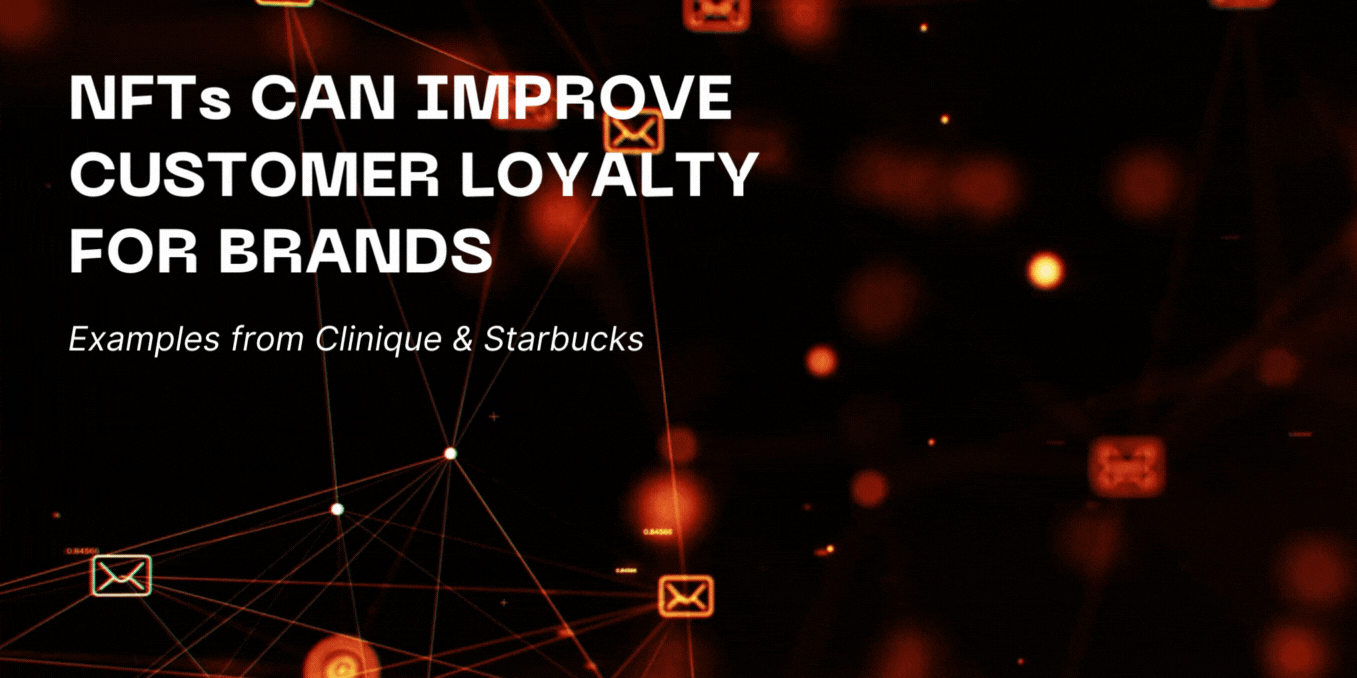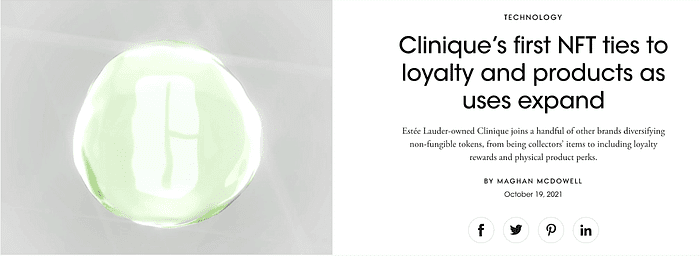NFTs can Improve Customer Loyalty for Brands

Examples from Clinique & Starbucks
From CSR to loyalty programs, discounts and special offers, or improving their customer service, brands have bent over backwards to improve their brand loyalty.
According to Business Wire, brands spend a collective $323 billion per year on their customer ecosystem, which includes loyalty management, customer engagement, and customer relationship management (CRM).
Why?
65% of revenue in most companies comes from repeated business with existing clients (Investopedia). Existing customers loyal to brands purchase 90% more frequently than new customers, and targeting the brand-loyal segment is also far less expensive than marketing to attract new customers.
Furthermore, 73% of companies depend more on current customers than on developing new markets (Retail Dive, 2021).
The struggle for web2 brands is real.

On the other side of the spectrum, web3 projects are thriving in an industry where collaboration replaces competition, and community engineering takes hold over customer satisfaction methods.
One of the key pillars of success in web3 marketing that has enabled leaders to build loyal communities are NFTs.
NFTs?
The Forbes definition describes it as a “digital asset that represents real-world objects like art, music, in-game items, and videos” that are “bought and sold online”.
This is a simplistic explanation of a much wider and not yet fully explored phenomenon enabled by the innovation of blockchain technology, but it will be sufficient for the intents and purposes of this article.
Since its introduction in 2014, NFT application has expanded widely to all sorts of areas, from premium auction houses like Christie’s to regulating and authenticating NBA tickets.
If you Google “non-fungible tokens,” you’ll get top results about NFTs of digital art being sold for millions of dollars at auction and pixelated profile pictures being purchased for tens of thousands of dollars. The NFT revolution is unquestionably being driven by a sizable degree of speculative thinking and FOMO (Fear of Missing Out). However, there is something essentially novel about this. NFTs provide brands the chance to rethink how they interact with their customers.
Deepening customer loyalty with emotional engagement
Cosmetics brand Clinique launched an online competition in October 2021 to encourage its followers to share positive stories. Winners of the contest received Clinique-branded digital collectibles, giving them access to their favorite out-of-stock items. Over the next ten years, the three NFT holders will get a variety of brand products while also claiming a piece of brand heritage.

One of the conditions to enter the competition was for contestants to join the Clinique Smart Rewards members program — giving therefore, access to its NFTs only to these members. This way, Clinique was both rewarding members and incentivizing others to join via sign-up.
By displaying their branded NFTs on their socials, Clinique became a part of their identity. Think of it as the digital equivalent of wearing a branded t-Shirt.

NFTs are becoming a way for customers to display the brands they love, the causes they believe in, the stories they relate to, and the art they appreciate.
Automation & direct to consumer loyalty programs
Thanks to the blockchain, customer relationship processes are automated, and only specific elements act as a trigger. This is made possible by smart contracts, which allow assets to be sent to the crypto wallet of the consumer who scanned the NFT.
As such, the rewards are awarded on an automated basis, saving the brand immeasurable time as it no longer has control over the loyalty program.
Once customers have agreed to connect their crypto wallet address to receive the benefits, brands will be able to use it to send new rewards or messages to the user to give them value and strengthen their loyalty.
A point of connection will thus be created for the brand to nurture its loyalty potential through the wallet. The user’s wallet thus becomes the point of contact for the brand, the new communication channel through which the brand will be able to develop its loyalty capacity.
The wallet gathers a lot of resources in terms of data on its user. It contains other forms of virtual assets such as numerical data, last purchases, tickets, loyalty cards, or what is called Proof of Attendance Protocol or POAPs
Brands can use it to keep the link with their users and use it as a push message before or after events. Concretely, a user visiting a site several times could, at the end of the 10th visit, receive in his wallet 10 POAPs, unlocking a voucher. This is another conception of the customer relationship, the CRM of web3 is mainly centered on the wallet and no longer on an email address.
Gamifying customers’ experience
Starbucks has recently introduced a customer loyalty program (still in beta) revolving around the technology: the Odyssey experience. They created an interactive ecosystem that sheds light on the company’s culture through which customers can play, learn, and earn NFTs.
Additionally, the company set up an NFT marketplace within its app, allowing customers to buy and trade exclusive collectibles with different levels of rarity. For the grand Finale, Starbucks conjured an on-point package of perks and benefits that can be accessed through your NFT collection, ranging from an online course on making espresso Martinis, to a trip through the coffee farms of Costa Rica.
By making members go through gamified ‘Journeys’, and rewarding them with lifetime and worldwide benefits through NFT utilities, Starbucks has managed not only to retain its customers but also to make them actively participate in the brand’s lifecycle.

Final thoughts
Web3 customer relationship is a new type of customer relationship that relies on blockchain technology to create a secure, transparent, and automated platform for customers to interact with businesses. It enables customers to have direct control over their data and transactions, allowing them to have greater trust and transparency in their interactions with businesses. Brands should rely on this new form of customer relationship while using NFTs in order to improve their brand loyalty.
To learn more on web3 and steps for brands to grow their communities, read The Love Story of Brands and NFTs.
To learn more about web3, check our articles.
Download our reports.
Watch our interviews.
